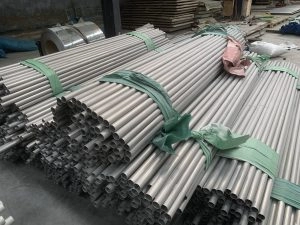Understanding Corrugated Stainless Steel Tubing
Common Applications of Corrugated Stainless Steel Tubing
Corrugated stainless steel tubing is extensively applied in residential, commercial, and industrial settings. One of its predominant uses is in gas distribution systems, where it facilitates the safe and efficient transport of natural gas or propane. Additionally, it is favored in plumbing systems for the transportation of water and other fluids due to its resistance to corrosion and flexibility, which allows for easier installation in tight spaces. HVAC systems also benefit from the use of CSST, as it can handle both high and low-temperature extremes, making it ideal for heating and cooling applications. Moreover, its robustness and flexibility make it suitable for use in earthquake-prone regions, as it can absorb seismic movements without breaking.
Benefits of Using Corrugated Stainless Steel Tubing
The use of corrugated stainless steel tubing offers numerous advantages. First and foremost, its flexibility allows for quicker and more efficient installations compared to rigid piping systems. The ability to bend and maneuver the tubing around obstacles reduces the need for connections and joints, which consequently lowers leak risks and enhances the system’s integrity. Another significant benefit is its corrosion resistance. Made from high-quality stainless steel, CSST is less likely to corrode or wear out over time, ensuring a longer service life. Additionally, its light weight makes it easier to handle and transport, further simplifying the installation process. Lastly, the durability and resilience of corrugated stainless steel tubing make it a cost-effective choice in the long run, as it reduces maintenance and replacement costs.
Factors Influencing the Longevity of Corrugated Stainless Steel Tubing
Material Quality
The longevity of corrugated stainless steel tubing is significantly influenced by the quality of the material used. High-grade stainless steel, which is rich in chromium and nickel alloys, provides excellent resistance to corrosion and environmental wear. The superior material quality ensures that the tubing can withstand high-pressure conditions and resist corrosive elements, prolonging its service life. It’s crucial to choose CSST that meets industry standards and specifications, as high-quality materials will enhance the durability and performance of the tubing over time.
Installation Practices
Proper installation practices are critical in determining the lifespan of corrugated stainless steel tubing. Incorrect installation can lead to issues such as leaks, excessive wear, and premature failure. It is essential to follow manufacturer guidelines and industry best practices during installation to ensure a secure and efficient system. Proper sealing of connections, avoiding excessive bending or kinking, and ensuring adequate support are key factors to extend the tubing’s lifespan. Hiring skilled professionals for installation can further mitigate risks associated with improper handling and setup.
Environmental Conditions
The environmental conditions in which corrugated stainless steel tubing is installed play a pivotal role in its longevity. Exposure to harsh conditions, such as extreme temperatures, corrosive chemicals, and high humidity, can accelerate wear and degradation. For instance, in coastal regions where saltwater exposure is prevalent, additional protective measures such as coatings or barriers may be necessary to prevent corrosion. Similarly, in industrial environments where the tubing may come into contact with aggressive chemicals, selecting a CSST variant specifically designed for chemical resistance will help maintain its integrity and prolong its service life.
Maintenance Procedures
Regular maintenance is essential to ensure the extended lifespan of corrugated stainless steel tubing. Routine inspections can help detect early signs of wear, corrosion, or damage, allowing for timely repairs or replacements. Maintenance procedures should include cleaning the tubing to remove any accumulated debris, corrosive substances, or build-up that can compromise its performance. Additionally, checking for leaks and ensuring that connections are secure can prevent minor issues from becoming major problems. Implementing a comprehensive maintenance schedule based on the tubing’s application and environmental conditions will significantly enhance its durability and operational efficiency.
Signs of Wear and When to Replace Corrugated Stainless Steel Tubing
Indicators of Deterioration
Despite its robust nature, corrugated stainless steel tubing can exhibit signs of wear and deterioration over time. Key indicators include visible corrosion or rust on the surface, which suggests that the protective layer of the steel has been compromised. Unusual odors, particularly of gas, can indicate leaks that may require immediate attention. Additionally, any noticeable deformation, such as kinks or bends that were not present during installation, could be a sign of structural compromise. Reduced performance, such as lower pressure in gas or water flow, can also suggest internal blockages or wear that needs to be addressed.
Best Practices for Inspection and Replacement
To ensure the longevity and safety of your corrugated stainless steel tubing system, regular inspection is vital. Conduct visual inspections periodically to identify any signs of wear, corrosion, or damage. Using leak detection solutions can help identify less obvious leaks along the tubing. It’s advisable to schedule professional inspections annually, particularly in systems that carry gas, to ensure compliance with safety standards. When signs of significant wear or damage are detected, prompt replacement of the affected sections is crucial. Following manufacturer guidelines for replacement and working with qualified professionals ensures that the new tubing is installed correctly and safely.
Industry Standards and Lifespan Expectations for Corrugated Stainless Steel Tubing
Manufacturer Guidelines
Manufacturers of corrugated stainless steel tubing provide detailed guidelines on the expected lifespan and maintenance procedures for their products. These guidelines typically estimate a lifespan ranging from 30 to 50 years, contingent upon proper installation and maintenance. Adhering to the manufacturer’s specifications for installation, such as correct fitting techniques and recommended support structures, is essential in achieving this lifespan. Following the prescribed maintenance schedules and using manufacturer-approved accessories and fittings also play a critical role in extending the tubing’s service life.
Regulatory Standards and Compliance
Compliance with industry standards and regulatory codes is imperative for the safe and effective use of corrugated stainless steel tubing. Various organizations, such as the American Gas Association (AGA) and the National Fire Protection Association (NFPA), set stringent guidelines for the installation and use of CSST, particularly in gas distribution systems. Ensuring that the tubing conforms to these standards guarantees not only the safety and efficiency of the system but also its longevity. Inspections by certified professionals help confirm that the installation meets all regulatory requirements, thus mitigating risks associated with non-compliance and substandard installations.
Enhancing the Longevity of Corrugated Stainless Steel Tubing
Regular Maintenance Tips
Cleaning Procedures
Regular cleaning is essential to maintain the integrity of corrugated stainless steel tubing. Dust, debris, and corrosive substances can accumulate on the tubing surface, potentially leading to corrosion or blockage over time. Using non-abrasive cleaning agents and soft cloths to wipe down the tubing can help maintain its condition. For the internal cleaning of water-carrying CSST, flushing the system with clean water periodically can prevent sediment build-up. Avoid the use of harsh chemicals that can damage the stainless steel finish, and consider protective coatings in harsher environments to add an extra layer of defense against corrosion.
Inspection Schedules
Establishing a regular inspection schedule is vital for detecting early signs of wear and preventing serious issues. Visual inspections should be conducted at least twice a year, while more intensive inspections, including pressure tests and leak detection, should be performed annually. In high-risk areas such as gas systems or commercial installations, more frequent inspections might be necessary. Keeping detailed records of all inspections and maintenance activities can help track the tubing’s condition over time and ensure that any potential problems are addressed promptly.
How to Choose Quality Corrugated Stainless Steel Tubing for Long-Term Use
Key Features to Look For
Thickness and Flexibility
When selecting corrugated stainless steel tubing, it is important to consider the thickness and flexibility of the material. Thicker tubing typically offers greater durability and can withstand higher pressures, making it suitable for demanding applications. Flexibility is equally important, as it allows for easier installation and reduces the need for numerous fittings and connections. Ensuring that the tubing maintains a balance between strength and flexibility can significantly enhance its longevity and performance.
Resistance to Corrosion
One of the key attributes of high-quality CSST is its resistance to corrosion. The presence of high chromium and nickel content in the stainless steel alloy is indicative of superior corrosion resistance. Some CSST variants also come with additional protective coatings that provide extra layers of defense against environmental factors such as moisture, chemicals, and salt. Selecting tubing with proven corrosion-resistant properties will ensure that it remains functional and reliable over an extended period.
Brand Reputation
The reputation of the brand manufacturing corrugated stainless steel tubing is a crucial factor in ensuring quality. Established brands with a history of producing reliable and compliant tubing are more likely to provide products that meet industry standards. Researching customer reviews, industry certifications, and warranty offerings can provide insight into the reliability and performance of the brand’s products. Opting for well-regarded manufacturers can reduce the risk of purchasing subpar materials and ensure the longevity and safety of the tubing system.
Sunrise New Materials is a global supplier of steel and non-ferrous metal raw materials. They provide reliable and customized supply solutions for customers worldwide. Known as a one-stop supplier, Sunrise New Materials is the preferred choice for thousands of customers. They have a strong supply chain, expert knowledge, and dependable services.
They offer a wide range of products, including stainless steel, and have invested in production lines in China. They work closely with major steel mills like Baosteel, Taiyuan Iron and Steel, and POSCO to ensure high-quality products.
To ensure quick delivery, they have set up large warehouses at major ports in China, allowing them to deliver products promptly.
Sunrise New Materials is committed to advancing the steel industry through intelligent manufacturing. They aim to be a leader in the industry by focusing on quality, innovation, and sustainability, contributing to the global steel industry’s growth.







